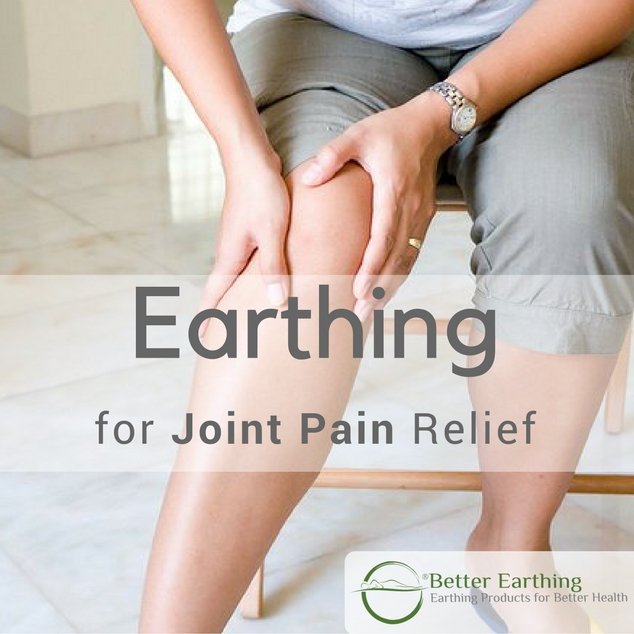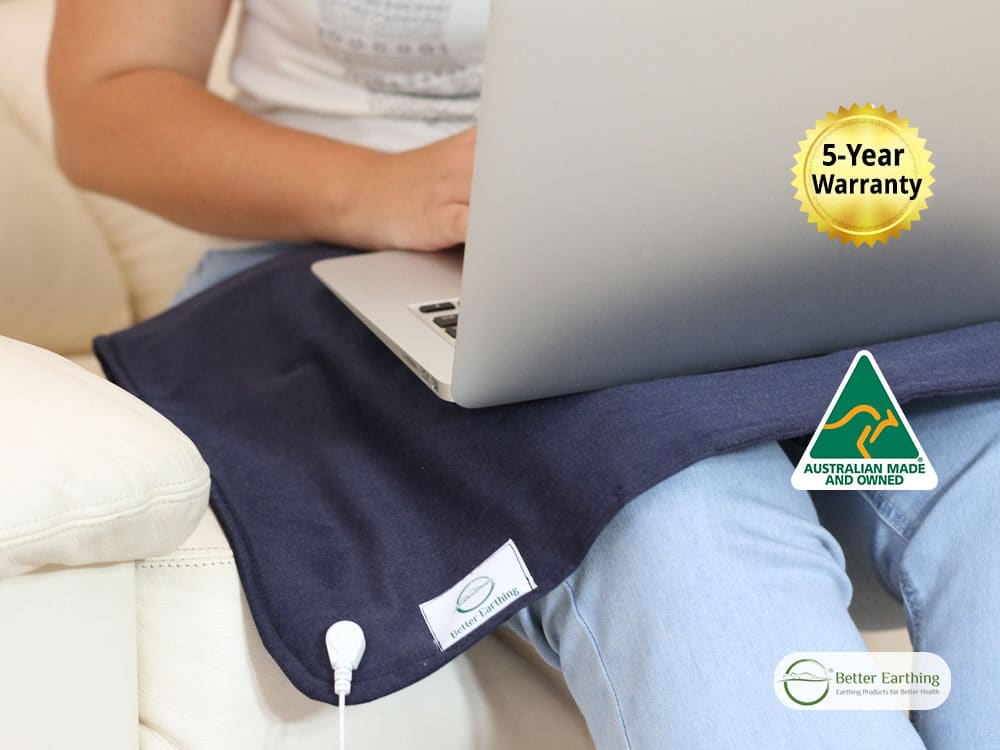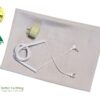Joint Pain Relief

If you are seeking relief from joint pain, you are not alone. Joint pain is a common condition that will affect the majority of people at some point during their lifetime.
Joint pain can be mild to severely debilitating making pain relief medication necessary. The most common treatments are anti-inflammatory drugs and painkillers. However, there are also many natural pain relief methods that may reduce the need for medication, and are safe and free from side effects. These include acupuncture, physiotherapy, massage, and earthing.
Earthing is the practice of being in conductive contact with the earth, and the health benefits of earthing are well documented. More on this later.
What Joint Pain Feels Like
Joint pain affects different people in different ways. It can range from a mild, dull ache to a severe throbbing or stabbing pain. It may be accompanied by heat, swelling, or stiffness.
For some people, joint pain comes and goes. For others, it is present all the time. It may be worse first thing in the morning on waking up, or get progressively worse over the day.
It may be relieved by applying heat or cold, by exercise or rest. It might be worse in certain weather conditions such as on cold or damp days. These factors, as well as the location and quality of joint pain, will depend on the cause.
What Causes Joint Pain?
There are many different causes of joint pain. Arthritis is one of the most common, but there are many more including the following:
- Sprains and strains
- Tendonitis
- Cartilage damage
- Fractures
- Bleeding into the joint
- Gout
- Fibromyalgia
- Lupus
- Cancer
Correctly identifying the cause of joint pain is the first step toward successful treatment. Some of the methods used to diagnose joint pain are X-ray or MRI imaging, blood tests, or surgical investigations.
When is Joint Pain Arthritis?
Arthritis is a term used to refer to inflammation of the joints. There are many different types of arthritis. The most well-known are osteoarthritis and rheumatoid arthritis.
Osteoarthritis is caused by general wear and tear of the joints, which happens with age. It is more common in older people and those who are overweight, as carrying around excess body mass puts more strain on the joints. It usually affects the weight-bearing joints such as the hips and knees and gets worse over time as the disease progresses.
Rheumatoid arthritis is an auto-immune disease. This means that the body’s immune system fails to recognise its tissues and attacks them. Rheumatoid arthritis is characterised by flare-ups of severe inflammation and swelling of the joints. It can affect anyone but is more common in women. Rheumatoid arthritis most often affects the joints of the hands, feet, and wrists.
Joint Pain Relief – Medication
Medication for joint pain relief is geared towards reducing inflammation and relieving pain. Some of the most common medications prescribed for joint pain are non-steroidal anti-inflammatory drugs (NSAIDs) such as ibuprofen. These can be taken orally or applied directly to the affected area as a gel or cream.
If further pain relief is required, other analgesic drugs such as paracetamol or co-codamol (paracetamol with codeine) are sometimes prescribed.
In very severe cases of joint pain, corticosteroids may be used. They can be taken orally to reduce acute inflammation, for example during a flare-up of rheumatoid arthritis. Otherwise, they may be injected directly into the affected joint.
Side Effects of Joint Pain Relief Medications
Joint pain medications have several possible side effects. NSAIDs can irritate the stomach lining and if taken over a long period may contribute to the formation of gastric ulcers. Taking these medications after food or applying them externally greatly reduces this risk. NSAIDs also need to be used with caution in patients with asthma, hypertension, and other cardiovascular diseases.
Paracetamol is generally safe and well-tolerated. Stronger analgesics that contain an opioid, such as co-codamol should only be taken in moderation. They can cause drowsiness, dizziness, and digestive issues such as constipation. Long-term use may also lead to addiction.
Corticosteroids are highly effective but should only be prescribed in short courses to avoid their potentially serious side effects. These include weight gain, raised blood sugar, reduced adrenal function, thinning of the skin, and increased risk of osteoporosis.
Natural Joint Pain Relief
There are many different ways to relieve joint pain naturally without the need for medication. One of the simplest things you can do at home is applying a heating pad or hot water bottle to the affected area, or icing the painful joint. Experiment with hot and cold to see which one works best for you.
It is a good idea to do some gentle exercise to keep the joints mobile and relieve stiffness and pain. Choose low-impact, non-weight-bearing exercises such as swimming, yoga, or tai chi. Even a gentle walk can be beneficial.
Physiotherapy or gentle, manual manipulation therapies such as osteopathy are good ways to mobilise the joints and relieve muscular tension. You will likely also be given exercises to do at home between treatments to maximise their effects.
Massage therapy is a good way to relieve muscle stiffness and pain. By relaxing the surrounding muscles, pain in the joints may also be reduced.
Acupuncture is another therapy, which can give joint pain relief. This ancient therapy involves placing fine needles at specific sites on the body known as acupuncture points. Acupuncture helps to relax the muscles, reduce inflammation and relieve pain.
Earthing or Grounding for Joint Pain Relief
The term “earthing” or “grounding” refers to bringing the body into conductive contact with the earth. This can have far-reaching benefits such as enhancing your body’s ability to heal itself, supporting the immune system, reducing inflammation and reducing recovery time after injuries.
The earth’s surface holds a subtle negative electrical charge. It is rich in what are known as free electrons. When you walk barefoot outside, the soles of your feet come into direct contact with the earth. This brings your body into balance with the earth’s electrical field.
In the book Bioelectromagnetic and Subtle Energy Medicine, James L. Oschman explains:
“The human body is a conductor of electricity and so is the earth. “Grounded” or “earthed” means that our bodies are conductively coupled or electrically coupled with the surface of the earth and its abundant supply of electrons. This is a natural condition in which earth’s free or mobile electrons spread over and into our bodies, stabilizing our internal electrical environment.”
These free electrons work in a similar way to antioxidants. Antioxidants are the compounds found in food and supplements and help to neutralize harmful free radicals. Free radicals are unstable molecules, which cause damage to cells and may contribute to a wide range of diseases as well as speed up the aging process.
Earthing yourself, either by walking barefoot outside or using an indoor earthing system, may help reduce free radicals and restore your natural biological rhythms.
Earthing can help reduce inflammation. It does this by regulating levels of the hormone cortisol. Cortisol is associated with stress and inflammation. The ability to influence cortisol levels in the body makes earthing an ideal solution for conditions such as joint pain and arthritis.
Earthing can be done by simply stepping outside and kicking off your shoes, or by using an indoor earthing product such as an earthing underlay or mat.
Do You Have Joint Pain at Night or in the Morning?
All living things, including humans, are governed by a biological clock. This is also known as circadian rhythm. Circadian rhythms are controlled by the hormones melatonin and cortisol, which are released according to the changes between night and day.
When it gets dark, your body releases melatonin. This causes you to become tired and fall asleep. When the sun rises, your body releases cortisol, which causes you to wake up and become active. Cortisol levels peak in the morning, at around 8 am, and gradually decrease as the day goes on.
Sometimes, this cycle gets thrown out of balance, either due to illness or stress. This can result in higher cortisol levels throughout the day. This is a problem because too much cortisol can harm your health. High cortisol levels increase inflammation and make joint pain worse.
If you suffer from joint pain at night, this can seriously interfere with your ability to sleep. In turn, lack of sleep increases joint pain, sparking a vicious cycle of joint pain and insomnia.
If you find your joint pain is worse when you first wake up, one 2016 study has discovered why. It found that anti-inflammatory proteins are suppressed when you sleep. This is the reason that you often feel stiff first thing in the morning.
Grounding Overnight for Joint Pain Relief
Earthing overnight is one way to relieve joint pain, reduce inflammation, and improve sleep. This 2004 study showed that sleeping on earthing bedding altered cortisol levels and improved pain and sleep for most of its participants. Those participants reported a significant improvement in their symptoms and general well-being after sleeping grounded to earth for just a few days.
Earthing overnight can be done by using a specially designed grounding sheet, underlay, or pillowcase that is made from conductive material, and connected to the earth using a special earthing lead that you connect to a metal rod staked outdoor or the third ‘earth’ port of your power point using a special lead and adapter. This method of earthing overnight is both safe and convenient for use at home.
The many benefits of grounding overnight include:
- Deeper sleep
- Falling asleep faster
- Waking less during the night
- Increased energy during the day
- Less emotional stress
- Reduced pain
- Reduced inflammation
- Faster recovery from muscular exertion
How to Get Started
Getting started with earthing is easy. Simply go outside, kick off your shoes, and stand barefoot on the grass or unpainted concrete. Doing this, you almost immediately begin to benefit from being in contact with the earth’s free electrons.
To benefit from earthing for longer each day, consider investing in earthing products to use within your home. Whether it be an earthing undersheet to improve your sleep, or a fabric grounding mat to use at your desk while you work, there is something available for everyone.
As well as relieving joint pain and reducing inflammation, earthing can give you a greater sense of health and well-being.
So what are you waiting for? Go outside and give it a try!
Earthing Research
Ghaly M, Teplitz D. ‘The biologic effects of grounding the human body during sleep as measured by cortisol levels and subjective reporting of sleep, pain, and stress’ Journal of Alternative and Complementary Medicine 2004;10 (5): 767–776.
Oschman J, Chevalier G, Ober, A.C. ‘Biophysics of Earthing (Grounding) the Human Body’ in Rosch P ed. Bioelectromagnetic and Subtle Energy Medicine. Routledge 2010.





